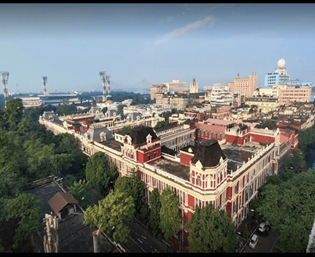Water Resource Accounting in India By Dr. Roopendra Singh, AAO PAG (Audit) Raipur
“When the well is dry, we learn the value of water” - Benjamin Franklin
Water: The word itself is an indication of life on the planet. About 60% of the human body contains water. A man needs 3.7 litres of water every day and a woman at least 2.7 litres of water daily. One can survive without food for days but cannot survive even hours without water. Water keeps us alive and active. Fresh water, which is a natural resource is the need of the hour. With global warming and increase in factors like industrialization and pollution, the ground water is depleting. The world is facing fresh water scarcity problem. Water accounting is the need of the hour for water resources management the world over. There is need for further research on government policies on water accounting for management of available water resources.
Introduction
As per the Government Accounting Standards and Advisory Board (GASAB) guidelines, the Asset Accounts on Mineral and Non-Renewable Energy are to be prepared by every State. Water Accounting is a systematic study of the status and trends in water supply, demand, accessibility and use in specified domains. The sources of water include surface, ground and soil water. The uses include: agriculture, mining, water supply services, sewerage, industry and household. The water accounting includes: stocks, flows, physical and virtual forms, monetary measurement units.
Water Resource Accounting
Water is a natural resource and an asset. The Asset Accounts on Mineral and Non-Renewable Energy Resources are in the form of tables. There are three tables, namely Basic asset account on Mineral & Non-Renewable Energy Resources (Table 1), Asset Accounts on Mineral & Non-Renewable Energy Resources along with sustainability of resources (Table 2) and subsidiary Asset Accounts linking detailed physical flows in respect of Mineral & Non-Renewable Energy Resources with the valuation of resources (Table 3).
The basic Asset Accounts capture the opening stock of the Asset, growth, discovery in stock, upward reappraisals/reclassifications, total addition of stock, reductions on extractions, normal losses, catastrophic losses, downward reappraisal, reclassification and revaluation of stock, physical flow in stock.
The demand for water is increasing substantially due to increasing population, growing urbanization, and rapid industrialization combined with the need for raising agricultural production. Therefore sustainable development and efficient management of water is an increasingly complex challenge to India. It has been estimated that More than 2.2 million people die each year from diseases related to contaminated drinking water and poor sanitation.
The first attempt for country wide assessment of ground water resources was made on adhoc norms in 1972. Subsequently, the Ground Water Over exploitation Committee in 1979 brought out a systematic methodology along with revised norms and procedures for categorization of areas. India accounts for 18% of the world's population and about 4% of the world's water resources. One of the proposed solutions to solve the country's water woes is the ‘ Indian Rivers Interlinking Project. Despite an extensive river system, safe clean drinking water as well as irrigation water supplies for sustainable agriculture are in shortage across India, in part because it has, as yet, harnessed a small fraction of its available and recoverable surface water resource. With the urbanisation drive comes steady growth in urban water demand. Urban water and wastewater management are relatively under-studied subjects in India. Virtual water refers to the water required in the production of a commodity or service. When goods and services are exchanged, so is the virtual water and this is referred to as virtual water trade. The water footprint of a country is defined as the volume of water needed for the production of the goods and services consumed by the inhabitants of the country.
Water accounting requires precise input data to provide accurate explanations of water allocation and depletion in river basins. This framework improves understanding of the basin’s complex hydrological processes by separating non-manageable, manageable, reserved, and committed flow for downstream demands and environmental flows with the interaction of land use on the basis of the water management classes.
The previous research work includes subjects as water accounting indicators and water accounting methodologies, various water policies and water programs exercised for water resource management, the impact of terrains and river basins on water management, water crises due to overpopulation and water run-off, water accounting in regions as Mahanadi river basin, Jharkhand, Coimbatore, NCT Delhi, Bangalore and Hyderabad. Researchers have stated that 57 % to 60 % of water available is utilized in agriculture purposes. Researchers have stated that water export of India is more than water import. Water export is mainly in the form of virtual water as oil, cereals, cotton, jutes, and semi-luxury goods. Researchers used primary data in form of surveys and statistical tests used by the researchers were frequency tables and percentage analysis.
Conclusion
Water can be measured only in terms of inflow and out flow but the opening stock can not be precisely known and so also the closing stock. The government is running various programs such as Jal Jeevan Mission, Jal Shakti Abhiyan and there is also National Water Mission but still the scarcity of water and availability of water to every citizen is a social responsibility. Advantages of water management includes reduced water and sewer costs, weather based irrigation controls, reduced energy usage, reduction of unbilled water, waste water treatment energy usage. Few recommendations include: turn off taps when not in use, avoiding overflow from overhead water tanks at homes and reuse of water at homes for cleaning and washing.
Continue Reading

From the Editor's Desk
Forty years ago, recognising the knowledge driven nature of our Institution, the quarterly publication of the “Journal of Management and Training” was initiated....

Reporting for impact - Improving readability of audit reports
The need for enhancing the value and impact of CAG’s audit has been an enduring concern...

Application of Machine Learning Algorithms in Audit
There has been a tremendous explosion of data available with public sector entities over the last 20 years...

Digital Accountability: Harnessing Photo Forensics for e-Services Audits
In an era where technology intertwines with governance, the shift towards online portals for delivering public services has been monumental...

Accessibility of Cutting-Edge Technologies in GIS and RS
The democratization of cutting-edge technologies such as Geographic Information Systems (GIS) and Remote Sensing stands as a huge shift, empowering...

Beneficiaries of Social Schemes and Assessment
Social programmes have evolved over the decades, aiming for increased coverage, higher entitlements, and better design by using technology for targeting...

Blue Carbon Accounting
Human beings thrive in diverse ecosystems but often simplify these ecosystems over time. This simplification occurs through targets...

Generative AI: The Age of Artificial Imagination
In the vast landscape of artificial intelligence, few innovations have captured the imagination of the humans and sparked as much excitement as...

A 1.5-year-old DAG in a 150-year-old Institution
It was on 14th December 2022 when our posting orders came while I was still attached as an Assistant Director in the CRA Wing in the Headquarters Office, New Delhi....



